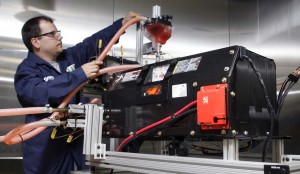
The new technology from the Argonne National Lab could squeeze more range out of a Chevy Volt battery pack, like this one.
The roll-out of electric vehicles is likely to be a slow one, most experts agree, because of the high cost, limited range and long charging times required by even the most advanced lithium-ion batteries.
But the Chicago-based Argonne National Laboratory has apparently come up with technology that could address at least two of those problems – and General Motors has just licensed the new material for use in battery-based vehicles like the Chevrolet Volt.
 If the technology lives up to expectations, it should permit GM engineers to address so-called “range anxiety” by squeezing more miles out of a battery between charges. The Argonne-developed material also allows batteries to be charged at higher voltages, which could reduce the time needed between charges.
If the technology lives up to expectations, it should permit GM engineers to address so-called “range anxiety” by squeezing more miles out of a battery between charges. The Argonne-developed material also allows batteries to be charged at higher voltages, which could reduce the time needed between charges.
Proponents of battery power have envisioned a network of 440-volt quick charge stations around the country that could permit a vehicle to top off its batteries in as little as 15 to 30 minutes. (For more on a new MIT study on quick charging, Click Here.)
The new material is a composited cathode, using both lithium and manganese. A battery consists of a cathode and anode, separated by an electrolyte that stores energy. A chemical reaction frees electrons that can be used to run the motors of an electric vehicle.
GM is the first to license the new technology, but its battery partner, LG Chem, has also inked an agreement with the Argonne lab. The Korean firm will begin using the new method of battery making when its $303 million plant in Western Michigan goes into operation in 2012. The license is limited to the U.S., but LG Chem can use the technology for other customers – which include Ford, which will use the Korean company’s batteries in its new Focus Electric model, which also comes to market in 2012.
Currently, the Chevy Volt is rated to get between 25 and 50 miles per charge before switching to gasoline power. (Range depends on driving style, road conditions and even weather factors.) How much more could be squeezed out with the new cathode GM isn’t saying. In fact, it’s unclear if the Volt will even make use of the Argonne lab breakthrough.
“We believe this will give us access to cutting-edge technology not for current vehicles, but rather future electrified vehicles,” said Jon Lauckner, the president of GM Ventures, during a conference call.
The announcement of the Argonne lab breakthrough underscores the federal government’s increased commitment to push the U.S. into a leading position on the development of battery-based vehicles. That has been backed by several billion dollars of loans and grant money, including a $151.4 million loan from the Department of Energy to LG Chem to help finance the new Michigan battery plant.
